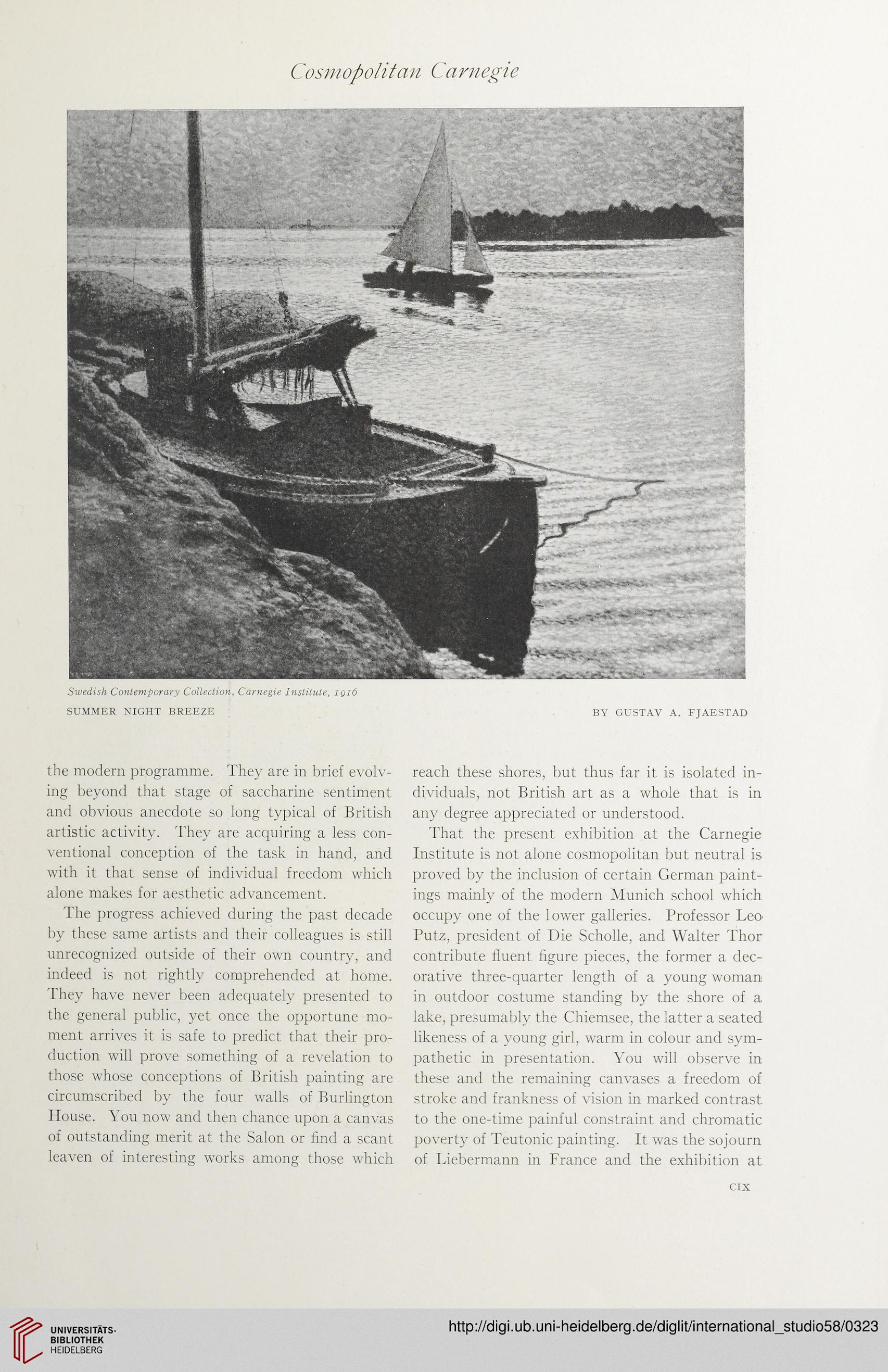Cosmopolitan Carnegie
Swedish Contemporary Collection, Carnegie Institute, 1916
SUMMER NIGHT BREEZE
BY GUSTAV A. FJAESTAD
the modern programme. They are in brief evolv-
ing beyond that stage of saccharine sentiment
and obvious anecdote so long typical of British
artistic activity. They are acquiring a less con-
ventional conception of the task in hand, and
with it that sense of individual freedom which
alone makes for aesthetic advancement.
The progress achieved during the past decade
by these same artists and their colleagues is still
unrecognized outside of their own country, and
indeed is not rightly comprehended at home.
They have never been adequately presented to
the general public, yet once the opportune mo-
ment arrives it is safe to predict that their pro-
duction will prove something of a revelation to
those whose conceptions of British painting are
circumscribed by the four walls of Burlington
House. You now and then chance upon a canvas
of outstanding merit at the Salon or find a scant
leaven of interesting works among those which
reach these shores, but thus far it is isolated in-
dividuals, not British art as a whole that is in
any degree appreciated or understood.
That the present exhibition at the Carnegie
Institute is not alone cosmopolitan but neutral is
proved by the inclusion of certain German paint-
ings mainly of the modern Munich school which
occupy one of the lower galleries. Professor LeO'
Putz, president of Die Scholle, and Walter Thor
contribute fluent figure pieces, the former a dec-
orative three-quarter length of a young woman
in outdoor costume standing by the shore of a
lake, presumably the Chiemsee, the latter a seated
likeness of a young girl, warm in colour and sym-
pathetic in presentation. You will observe in
these and the remaining canvases a freedom of
stroke and frankness of vision in marked contrast
to the one-time painful constraint and chromatic
poverty of Teutonic painting. It was the sojourn
of Liebermann in France and the exhibition at
cix
Swedish Contemporary Collection, Carnegie Institute, 1916
SUMMER NIGHT BREEZE
BY GUSTAV A. FJAESTAD
the modern programme. They are in brief evolv-
ing beyond that stage of saccharine sentiment
and obvious anecdote so long typical of British
artistic activity. They are acquiring a less con-
ventional conception of the task in hand, and
with it that sense of individual freedom which
alone makes for aesthetic advancement.
The progress achieved during the past decade
by these same artists and their colleagues is still
unrecognized outside of their own country, and
indeed is not rightly comprehended at home.
They have never been adequately presented to
the general public, yet once the opportune mo-
ment arrives it is safe to predict that their pro-
duction will prove something of a revelation to
those whose conceptions of British painting are
circumscribed by the four walls of Burlington
House. You now and then chance upon a canvas
of outstanding merit at the Salon or find a scant
leaven of interesting works among those which
reach these shores, but thus far it is isolated in-
dividuals, not British art as a whole that is in
any degree appreciated or understood.
That the present exhibition at the Carnegie
Institute is not alone cosmopolitan but neutral is
proved by the inclusion of certain German paint-
ings mainly of the modern Munich school which
occupy one of the lower galleries. Professor LeO'
Putz, president of Die Scholle, and Walter Thor
contribute fluent figure pieces, the former a dec-
orative three-quarter length of a young woman
in outdoor costume standing by the shore of a
lake, presumably the Chiemsee, the latter a seated
likeness of a young girl, warm in colour and sym-
pathetic in presentation. You will observe in
these and the remaining canvases a freedom of
stroke and frankness of vision in marked contrast
to the one-time painful constraint and chromatic
poverty of Teutonic painting. It was the sojourn
of Liebermann in France and the exhibition at
cix




